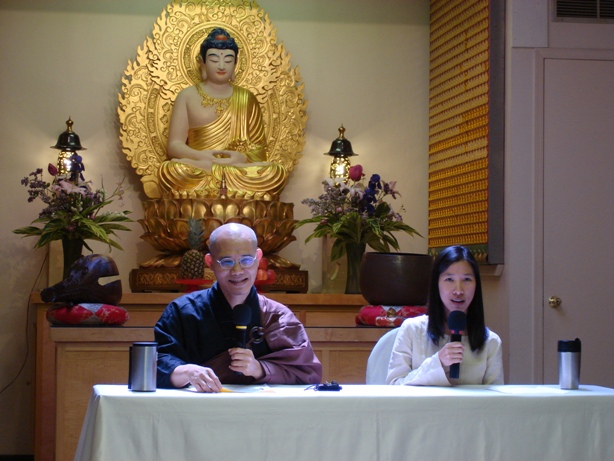| |

How Do You See People?
By Chang Jie
05/10/2009

On Sunday, May 17, 2009, Venerable Guo Xing, Abbot of CMC and Dharm Drum Retreat Center gave a talk entitled, "How Do You See People?"
According to Venerable, the ability to read people is a useful skill that can be used in everyday life-from recruiting
the right person in the workplace, to finding the right mate. At Dharma Drum Mountain, monastics received training in order to read and
understand people. According to this particular type of training, people can be categorized into 5 types: tigers, owls, peacocks,
chameleons and koala bears. Each personality type has its own unique characteristic--people who are like tigers tend to be domineering
and demanding. Owls are detail-oriented and make ideal lawyers and accountants. Peacock types make good salespeople and marketers because
of their optimistic outlook, and chameleons change their outlook and behavior depending on the scenario and the people around them. Koala
bears tend to be calm, harmonious and make good caregivers, such doctors.
In Chan practice, however, there is no idea of a separate person apart from oneself. In fact, there is no discrimination between people.
Rather, we let go of the notion of a separate person.
We ordinarily mistake the ideas and images of a person to be the true person. In Chan practice, these ideas and images are called
wandering thoughts. When we meditate on our cushions, we realize these ideas and images are not real, but when we leave our cushions,
we treat these images and ideas as real. In our interactions with other people and our surroundings, everything enters our consciousness
as sight, sound, smell, taste, touch, and thought. We treat these mental images and ideas in our minds as real. From this, we start to
engage in discrimination of liking and disliking. To remedy this habit of mind, we can ask ourselves if the images and notions in our
minds or are real. This will help reduce our negative emotions such as anger and frustration.

The mind has many different functions, based on our sensory organs. The mind experiences sight when we see with our eyes and sensation
when the body experiences touch. We can use the metaphor of the puppet show to think about the mind. The mind is like the hand inside
the puppet. The puppet itself is nothing but a cloth bag, but the function of the hand, which is like the mind, makes the puppet move
to perform various activities. What is the function of mind when there is no sensory input?
The Vimalakirti Sutra teaches that when we observe people, we should treat them as reflections in a mirror. In Chan tradition, all
sentient beings have attained Buddhahood alreadyówe are merely trying to help them manifest the function of wisdom. We may ask
ourselves, when we see sentient beings, do we see the perfect function of Buddhanature, or do we see their appearance and behavior
as marked by vexations?
Shifu taught that we should treat the minds of sentient beings as our own mind. We usually think that others have discriminating
minds. But, in reality, there is no discrimination, just mind. One cannot draw a border between oneís own mind and the otherís mind.
When we are truly able to see that our true mind is no different from each other, then we will be more likely to be able to realize
and experience the state where there is no other separate from oneself.
Shifu taught that we should work with the other personís speech and bodily conduct. While most people cannot observe another personís
mind and thoughts, we can observe their speech and bodily conduct to understand what they need at that moment and find how we can help
that person. Then we are better able to establish positive affinities with that person, influence, and be of benefit to that person.
We can transform that personís view of discrimination of good and bad, duality of self and others, to understanding of no-self and
others, non-discrimination between self and others, and other kinds of discriminatory world views, which is itself a function of
wisdom. This practice of using the otherís mind as oneís mind, treating sentient beings minds as oneís mind, so we can better take
care of other peopleís needs, is the cultivation of compassion. At the same time, because we are focusing on how best to fulfill
another personís needs, we also minimize our self-centered attachment, which is another form of cultivation of wisdom.
At the end of the talk, there was a brief question and answer session.
|
|